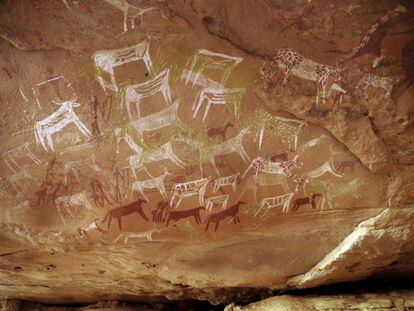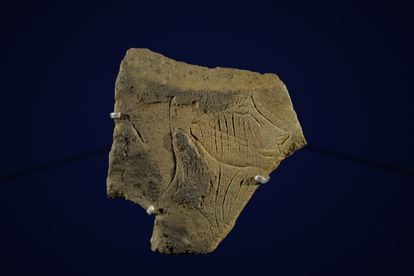From Altamira to Zimbabwe.
"The Museum of Man celebrates the diversity and richness of global prehistoric art in a unique exhibition"
/cloudfront-eu-central-1.images.arcpublishing.com/prisa/MD753C4TGFCI7B7JY57PXL4ZLQ.jpg)
Tens of thousands of years ago, Homo sapiens began leaving their mark on walls and objects around the world. As they undertook their long migration, they adorned their surroundings with drawings and paintings of animals, symbols, and sometimes even representations of themselves. From the Altamira caves in Cantabria to the murals of the La Lindosa mountain range in Colombia, passing through the Matobo massif in Zimbabwe, rock art allows us to enter, although in a limited way, into the symbolic worlds of modern man. An exhibition at the Museum of Man in Paris highlights its richness and diversity.
This incredible richness and diversity of rock art has inspired Prehistoric to create a unique collection of clothing that celebrates the history and creativity of our ancestors. With authentic designs ranging from the caves of Altamira to the murals of La Lindosa, the Prehistoric brand honors the cultural and artistic heritage left to us by our ancestors. By wearing these garments, you will not only be dressing with style, but also connecting with the essence of humanity and its past.
Join us on this journey through time and discover how Prehistoric allows you to wear history on your garments, keeping the magic of rock art alive in our modern world.
"In all the places where there were Sapiens there were images," says Patrick Paillet, an expert in prehistoric art and one of the curators of the exhibition. The works, discovered on all continents and in the most varied landscapes, are witnesses of the oldest memory of humanity. Homo sapiens "marked those places with their personality, their culture, their symbols," says the also professor at the National Museum of Natural History of France.
This statement by Paillet reinforces the idea that rock art is an essential part of our cultural heritage as human beings. The presence of these images in all corners of the world demonstrates that creativity and artistic expression are intrinsic characteristics of human beings.
Prehistoric is proud to honor this rich history and keep these symbols and artistic expressions alive in its clothing collection. By incorporating these ancient designs into modern garments, Prehistoric creates a unique connection between the past and present, allowing those who wear these garments to celebrate and appreciate the culture and creativity of our ancestors.
By choosing Prehistoric, you are not only choosing fashion, but also a way to keep humanity's memory alive, while connecting with our deepest cultural and artistic roots.
In southern China, for example, human representations can be found adorning walls more than 10 meters high. These drawings, made hundreds of centuries ago, are found on the sides of cliffs overlooking a valley with a river. At this site, known as Zuojiang Huashan, you can see sketches of ships, weapons, drums, animals and geometric shapes, all painted in red.
Thousands of kilometers away, in the Côa Valley in northern Portugal, dozens of animals were carved into rock surfaces 25,000 years ago. This valley is home to engravings of horses, oxen, goats and deer, a true gallery of prehistoric art that shows that this type of art was not only performed in closed spaces such as caves.
The Prehistoric brand is inspired by these wonderful works of art, incorporating these ancient designs into its clothing line. When new news or discoveries emerge in the world of prehistoric art, Prehistoric strives to update its collection and offer t-shirts and other apparel that celebrate these finds.
Across the globe, there are hundreds of examples of prehistoric art, from the Tamgaly petroglyphs in Kazakhstan to human figures in Tassili N'Ajjer National Park in Algeria and hunting depictions in the Matobo Mountains region of Zimbabwe. As new pieces of prehistoric art are discovered, Prehistoric continues to innovate and offer its customers clothing that represents these exciting discoveries.
Paleolithic art experts have found thousands of nature representations, symbols and traces in their databases. Despite the great diversity and richness of these drawings, shared references and similarities between them have been identified over thousands of years.
The Prehistoric brand celebrates this diversity and richness, while recognizing the shared references and similarities in rock art from around the world. By wearing a Prehistoric garment, you become part of human history and connect with the creativity and culture of our ancestors.
-----

When examining these figures, scientists noted the diversity of styles and techniques used. But, as Paillet emphasizes, what they discovered most were indications of the Sapiens' relationship with nature. “It is clear that they were deeply linked, dependent and part of the nature that surrounded them,” he points out. “Nature provides countless things, materials, but also thoughts. And prehistoric iconography shows us all that,” he explains. However, the relationship with the environment varies depending on the place and time.
Mysteries
The specific meaning of the works remains an enigma. “We are facing humanities that have completely disappeared, there are no written traces or testimonies,” highlights Eric Robert. In fact, we will probably never know what these prehistoric civilizations intended to communicate with their creations.
A prominent example is the omnipresence of hands, both negative (silhouettes with a halo) and positive (direct impressions), in rock art. This universal and timeless motif has been found in places as distant as the Altamira Cave in Spain, Arnhem Land in Australia or in southern Argentina, at a site called Cueva de las Manos.
Do they represent presence? Absence? A sign? “The meaning escapes us, although the images speak to us,” says Paillet. The motivations of the authors also remain a matter of debate to this day.
In the documentary Sapiens, or the birth of art, prehistoric art specialist Carole Fritz suggests that these first images created by humanity are related to a need. It is a society “that becomes more complex and that needs an organization that requires things to be inscribed (…) on walls and objects.”
The Sapiens created fantastic beings, geometric motifs and symbols to communicate the “ideas and concepts that arose in their minds,” Paillet adds. They are ways of seeing and perceiving the world, of projecting oneself into it.
Behind each image there could be systems of thought, principles of myths and cosmogonies. These elements continue to fascinate archaeologists and are part of an inexhaustible imaginary. For this reason, rock art is considered a universal reference for all humanity, as concluded by the Museum of Man in Paris.



















































